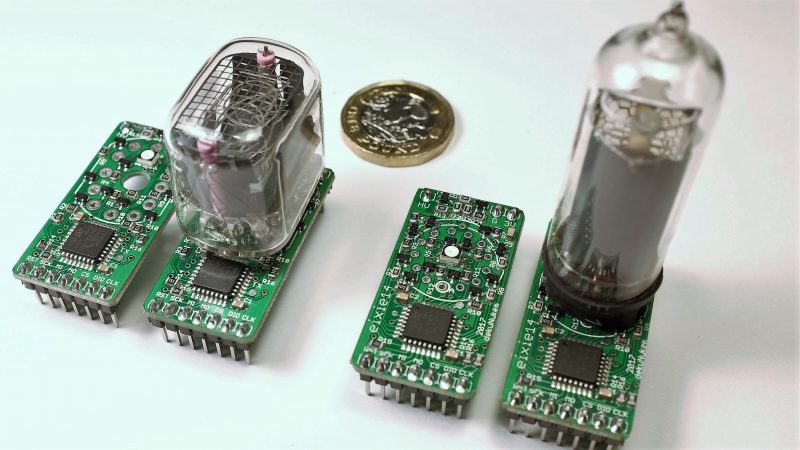We know, we know — yet another Nixie clock. But really, this one has a neat trick: an easy to use, feature packed driver for Nixies that makes good-looking projects a snap.
As cool as Nixies are — we’ll admit that to a certain degree, familiarity breeds contempt — they can be tricky to integrate. [dekuNukem] notes that aside from the high voltages, laying hands on vintage driver chips like the 7441 can be challenging and expensive. The problem was solved with about $3 worth of parts, including an STM32 microcontroller and some high-voltage transistors. The PCBs come in two flavors, one for the IN-12 and one for the IN-14, and connections for the SPI interface and both high- and low-voltage supplies are brought out to header pins. That makes the module easy to plug into a motherboard or riser card. The driver supports overdriving to accommodate poisoned cathodes, 127 brightness levels for smooth dimming, and a fully adjustable RBG backlight under the tube. See the boards in action in the video below, which features a nicely styled, high-accuracy clock.
From Nixie tachs to Nixie IoT clocks, [dekuNukem]’s boards should make creative Nixie projects even easier. But if you’re trying to drive a Nixie Darth Vader, you’re probably on your own.
















Boooring. If you can use tubes like some sort of 7 Seg. LED Display, where’s the fun building one?
Some people love to build, learn, and try. Others like to see, like, and buy.
Those aren’t the only types. I love to build, learn, and try, but I don’t always like to do that for absolutely every part of a project. I understand how to drive Nixie tubes and I could make a driver myself, but if there’s a good ready-made solution to do it, why should I waste my time on NIH syndrome?
That said, KAN is right, the high voltage traces on these boards run very close to ground planes and stuff, so at least a revision of these boards might be a good idea.
+100 makers vs consumers
Oh I dunno, a modular HV supply with a 32-bit RISC MCU seems like a cool thing to have kicking around the parts drawer.
I like the way you think.
What’s the fun in buying a spanner when you can make one?
Looks like a cool idea, but where’s the isolation on his PCBs? Some of those traces look nervously close to HV.
So…. Where do you buy them at?
https://github.com/dekuNukem/exixe#buying-some
Thanks!
Would be nice if the author included a PDF of the schematic and gerbers for the PCB layout, rather than whatever proprietary format a .brd is (Eagle?)
Interesting implementation, one thing i don’t like is that the SPI implementation is not daisy chain-able, each module will need its own CS line, but i guess since you already have access to the code you can rewrite it to basically make ‘595 on steroids :)
Also the math for the “cathode” resistor seems to be wrong and the power rating for the 0805 resistor used for current limiting is a bit too close to the limit.